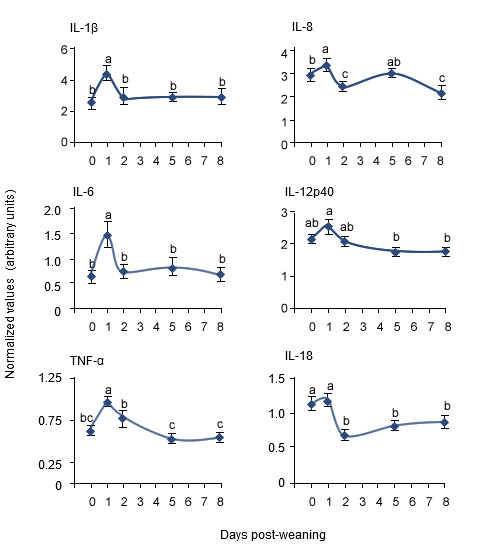The gastrointestinal tract (GIT) of the young pig is colonized immediately after birth by bacteria derived from the maternal vagina, faeces and skin as well as the external environment, e.g., piglets born into outdoor systems. The early-life succession and stabilization of the GIT microbiota occurs concomitantly with the development and functional expansion of the mucosal immune system, as has been clearly shown in germfree pigs that demonstrate strong and sustained effects of colonization on the GIT immune system. There is also a profound influence of the early rearing environment, and therefore the microbiological milieu into which a neonate is born into, on subsequent immunological and physiological development. Piglets, nonetheless, are born largely in an immunodeficient state and depend primarily on a supply of both specific and non-specific immune factors such as immunoglobulins and other proteins present in the sow’s colostrum and milk for immune protection, development and ultimately, survival. The functional immaturity of the neonatal cellular and secretory immune systems means that newborn piglets can only generate limited T and B immune cell responses when challenged with pathogens and antigens, thus contributing further to their immunocompromised state (Stokes et al. 2004). Nevertheless the young pig needs to become immunologically competent as it grows and develops and become able to tolerate the wide range of antigens associated with pathogens and commensal bacteria and food that it encounters.
The cells and structures involved in GIT mucosal (epithelial) immune responses are initially absent at birth and generally populate the GIT of the young pig in a highly defined and programmed sequence (refer to Table 1). From this it is evident that the mucosal immune system (innate and adaptive) is relatively immature throughout the general time period that weaning occurs under current commercial conditions, i.e., ≈ 17 to 29 days of age. This, interestingly, coincides with the removal of both immunoregulatory and immunoprotective components of maternal milk, and numerous studies have demonstrated the benefits of including milk products or milk-derived factors in the diets of newly-weaned pigs in developing immune competence and enhancing performance. It is not until the pig is ≈ 7-8 weeks of age that the architecture and function of the GIT immune system is comparable to that of a mature (‘adult-type’) pig. Given the challenges the young pig must withstand at, and then adapt to after weaning, coupled with legislation and restrictions on the use of antimicrobial compounds in pork production worldwide, then there is considerable interest in whether this sequence of phenotypic development can be altered in the peri-weaning period, for example through nutritional, microbial and (or) environmental manipulation.

Table 1. Summary of the phases of development in relation to the different components
of the mucosal immune system of the young pig (reproduced from Bauer et al, 2007).
| Period of life | Components of the mucosal immune system |
| Birth |
|
| First two weeks |
|
| Two to four weeks |
|
| Five weeks onwards |
|
The lamina propria of the GIT epithelium is a critical component of the gut-associated lymphoidal tissue (GALT) in determining active immune responses and tolerance in mature pigs (Stokes et al. 2004). By inference, therefore, understanding mechanisms by which this is established and maintained in young pigs and the impacts of weaning (and events that occur before weaning) on immunological homeostasis can provide insights to modulation of the innate and adaptive immune responses that, in turn, may favourably modulate production and (or) health outcomes. The piglet for example is capable of active immune responses to live virus and to dietary components by 21 days of age, but quantitatively and qualitatively these responses differ markedly from that in older animals, e.g., at 9 weeks of age (Bailey et al, 2004). Exogenous specific/non-specific immunomodulation during this period of relative immunological quiescence represents a potentially important prophylactic/therapeutic approach to mitigate the nutrition-, stress- and disease-induced events that occur at weaning.
At weaning, the pig experiences marked physiological, environmental, and social challenges (stressors) that can predispose it to subsequent diseases and other production losses. A period of sub-optimal feed (and water) intake occurs in association with profound physiological changes in the structure and function of the GIT, including deleterious effects on barrier integrity and function (Pluske et al, 1997). This ‘acute’ post-weaning phase is also associated sometimes with the proliferation of pathogenic bacteria in the GIT. Collectively, these changes are generally associated with a transient up-regulation of certain pro-inflammatory cytokines such as IL-1β, IL-6 and TNF-α, which are inflammatory mediators produced in response to tissue damage and contribute further to the anatomical and functional disorders seen in the GIT around this time (Figure 1). The post-weaning “growth check” continues to be a challenge to nutritionists, veterinarians and producers, and hence investigations into how nutrition (e.g., specific amino acids, dietary fibre components), management (e.g., weaning age, stress), environment (e.g., indoor versus outdoor rearing of young), antimicrobial compounds/feed additives (e.g., probiotics, immunostimulatory compounds), and the microbiota confluence to modify immune function continue to occur.
Figure 1. Changes in the expression of pro-inflammatory cytokine messenger RNA levels
(expressed as arbitrary units) in the jejunum around the time of weaning (reproduced from Pié et al. 2004).

In summary, the immune system of the GIT maintains its ability to mount active immune responses against pathogens, and tolerance to food antigens and the commensal biota, by a highly complex network of cellular and molecular interactions. These occur in a range of sites along the length of the GIT. The rate and sequence of mucosal immune maturity from birth to an ‘adult-type’ pig is an important determinant of subsequent performance, health and survival, and hence impacts on the efficiency and profitability of pork production.




